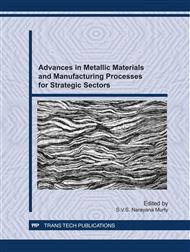p.389
p.395
p.401
p.407
p.412
p.421
p.427
p.433
p.439
Challenges in Characterization and Acceptance of Metal Matrix Composite “Carrier Plate” Material for Space Applications
Abstract:
In space applications, day by day, the electronic devices are becoming compact with increase in operating frequencies and high power requirements posing challenges in design and selection of materials for high thermal dissipation requirements. In order to achieve optimum performance from thermal management material, engineers have to focus on high reliable, cost effective alternatives. Such materials need to demonstrate excellent thermal conduction to minimize thermo-mechanical stress and fatigue due to operations like soldering, thermal cycling and severe operating conditions. The paper describes a new family of thermal management composite material called “SILVAR”.
Info:
Periodical:
Pages:
412-417
Citation:
Online since:
January 2012
Authors:
Price:
Сopyright:
© 2012 Trans Tech Publications Ltd. All Rights Reserved
Share:
Citation:


